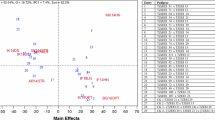Abstract
Breeders need a simple and reliable index that could be used to make selection quickly in a breeding program. A study was conducted at the International Institute of Tropical Agriculture, Nigeria, to compare efficiency of four selection indices in selecting the best genotypes in a population improvement program involving a yellow-grained (DMR ESR-Y) and white-grained (DMR ESR-W) maize (Zea mays L.) population under artificial stem borer infestation. Rank summation index (RSI), Base index (BSI), Multiplicative index (MI), and Optimum index that uses heritability as weight (OI) were compared using grain yield, plant aspect, ear aspect, stalk breakage, and tolerance to stem borer as selection criteria. The selection criteria had moderate to high narrow-sense heritability. Each of the traits had a significant correlation with all selection indices, except MI in DMR ESR-Y. The BSI had the highest selection differential (23.32%) followed by OI (21.45%) in the white maize population. It also had the highest (29.11%) followed by RSI (20.99%) in the yellow maize population. The BSI also had strongest correlation with RSI in the white (−0.95**) and the yellow maize population (−0.90**). Percentage similarity was highest between BSI and RSI in the white (82.6%) and yellow maize populations (72.3%). This suggested that both BSI and RSI are good selection indices that could be used in improvement programs for stem borer resistance in maize.
Similar content being viewed by others
References
Adebayo MA, Kolawole AO, Raji I, Ajayi J. 2017. Agronomic evaluation of testcrosses of drought-tolerant maize (Zea mays L.) inbred lines using different selection index methods. Arch. of Agron. Soil Sci. 63(9): 1292–1300
Ajala SO. 1992. Inheritance of resistance in maize to the spotted stem borer, Chilo partellus (Swinhoe). Maydica 37: 363–369
Ajala SO. 2010. Expected responses to aggregate trait selection in maize (Zea mays L). Int. J. Food, Agric. Environ. 8(1): 185–189
Ajala SO, Ago CE, Olaoye G. 2009. Comparism of predicted responses to three types of recurrent selection procedures for the improvement of a maize (Zea mays L.) population. J. Plant Breed. Crop Sci. 1(8): 284–292
Almeida LM, Viana AP, Júnior AT, Júnior JC. 2014. Breeding full-sib families of sugarcane using selection index. Ciência Rural, Santa Maria 44(4): 605–611
Asghar, MJ, Mehdi SS. 2010. Selection indices for yield and quality traits in sweet corns. Pak. J. Bot. 42(2): 775–789
Baker RJ. 1986. Selection Indices in Plant Breeding, CRC Press, Boca Raton, FL, USA, 218 pp
Baker RJ. 1994. Breeding methods and selection indices for improved tolerance to biotic and abiotic stresses in cool season food legumes. Euphytica 73: 67–72
Cargnin A, de Souza MA, Machado CG, Pimentel AJB. 2007. Genetic gain prediction for wheat with different selection criteria. Crop Breed. Appl. Biotech. 7: 334–339
Elston RC. 1963. A weight-free index for the purpose of ranking of selection with respect to several traits at a time. Biometrics 19 (1): 85–97
Falconer DS. 1989. Introduction to Quantitative Genetics, 3rd edition, New York, Longman Inc. 438
Ghaed-Rahimi L, Heidari B, Dadkhodaie A. 2017. Construction and efficiency of selection indices in wheat (Triticum aestivum L.) under drought stress and well-irrigated conditions. Plant Breed. Biotech. 5(2): 78–87
Hazel LN. 1943. The genetic basis for constructing selection index. Genetics 28: 476–490
Hazel LN, Lush JL. 1942. The efficiency of three methods of selection. J. Hered. 33: 393–399
Johnson HW, Robinson HF, Comstock RE. 1955. Genotypic and phenotypic correlations in soybeans and their implications in selection. Agron. J. 47: 477–483
Mehdi SS. 1986. Predicted response to S1 selection for yield and disease resistance traits in two sunflower populations. Ph.D. thesis, South Dakota State Univ., Brookings, SD, USA
Mohammadi M, Karimzadeh R, Youseiazar M. 2013. Investigation of selection efficiency in safflower (Cartamus thinctorius L.) genotypes. Nat. Mont. Pod. 12: 165–180
Mulumba NN, Mock JJ. 1978. Improvement of yield potential of Eto Blanco maize (Zea mays L.) population by breeding for plant traits. Egypt. J. of Genet. Cytol. 7: 40–51
Oloyede-Kamiyo QO. 2013. Genetic variability for stem borer resistance in two adapted early-maturing maize (Zea mays L.) populations. Ph.D. Thesis. Department of Agronomy, University of Ibadan. Nigeria
Pesek J, Baker RJ. 1969. Desired improvement in relation to selection indices. Can. J. Plant Sci. 49: 803–804
Robinson HB, Comstock RE, Harvey PH. 1951. Genotypic and phenotypic correlations in corn and their implications in selection. Agron. J. 43: 283–287
Shankar K, Ahluwalia M, Jain SK. 1963. The use of selection indices in the improvement of a pearl millet population. Ind. J. Genet. Plant Breed. 23: 30–33
Sikka SM, Jain KBL. 1958. Correlation studies and the application of discriminant function in Aestivum wheats for varietal selection under rain fed condition. Ind. J. Genet. Plant Breed. 18:178–186
Singh KB, Mehndiratta PD. 1970. Path analysis and selection indices for cowpea. Ind. J. Genet. Plant Breed. 30: 471–475
Smith HF. 1936. A discriminant function of plant selection. Ann. Eugen. 7: 240–250
Smith OS, Hallauer AR, Russell WA. 1981. Use of index selection in recurrent selection programs in maize. Euphytica 30: 611–618
Subandi, Compton WA, Empig LT. 1973. Comparison of efficiencies of selection indices for three traits in two variety crosses of corn. Crop Sci. 13: 184–186
Williams JS. 1962. The evaluation of selection index. Biometrics 18: 375–393
Acknowledgements
This work was supported by the International Institute of Tropical Agriculture (IITA), Nigeria.
Author information
Authors and Affiliations
Corresponding author
Rights and permissions
About this article
Cite this article
Oloyede-Kamiyo, Q.O. Efficiency of Index-Based Selection Methods for Stem Borer Resistance in Maize (Zea mays L.). J. Crop Sci. Biotechnol. 22, 205–211 (2019). https://doi.org/10.1007/s12892-017-0130-0
Received:
Revised:
Accepted:
Published:
Issue Date:
DOI: https://doi.org/10.1007/s12892-017-0130-0



